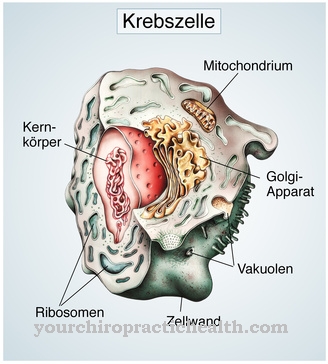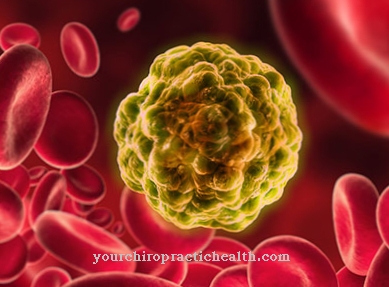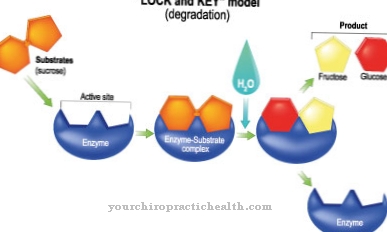A Connective tissue weakness manifests itself in different, optically more or less visible impairments of normal and attractive skin. The weakness of the connective tissue can occur at a young age or at an advanced age.
What is connective tissue weakness?

The connective tissue, which, as the name suggests, is affected by a weak connective tissue, is located in various organs of the body. Not only the outer skin, but also many internal organs are characterized by a layer of connective tissue.
Like all layers of tissue in the skin, connective tissue can also be affected by increasing slackness and a loss of elasticity. The connective tissue cells, which can be damaged in the course of life and by impairments that can hardly be influenced, die, harden and lose their functionality.
A connective tissue weakness is defined by the decreasing supporting and stabilizing effect that the connective tissue actually has to fulfill. In addition, if there is a weak connective tissue, the actual sliding and shifting function can no longer be guaranteed to a sufficient extent.
causes
As part of medical diagnostics, different causes are given for a weak connective tissue. First of all, physical changes come into question, which include, in particular, being very overweight, stretching of the skin due to pregnancy and insufficient food and fluid intake.
Often the skin can no longer compensate for alternating stretching due to the constant slackening of connective tissue associated with it, so that connective tissue weakness occurs. Insufficient physical activity and normal, progressive aging of the skin are also causes of weak connective tissue.
The strength and stability of the connective tissue is determined by the amount of collagen fibers in the connective tissue. This trait can be genetic and favor a weak connective tissue. Connective tissue weakness affects both female and male patients and overweight children.
Symptoms, ailments & signs
Connective tissue weakness is a condition that is particularly feared by women and is associated with a number of symptoms that are regarded as a cosmotic problem. If the surface tissue is no longer properly supported by the conjunctiva, the dreaded orange peel (cellulite) develops. Clearly visible dents form in the skin, which are particularly pronounced on the buttocks and thighs.
In some women, cellulite is also noticeable on the stomach or upper arms. In addition to orange peel, stretch marks are also a sign of weak connective tissue. The stripes, which are usually bluish at the beginning and fade over time until only a light stripe is visible, are tissue injuries due to overstretching of the skin. The stripes are mainly found on the stomach, hips, thighs and breasts.
Neither orange peel nor stretch marks, which are usually the result of pregnancy or severe weight fluctuations, are dangerous or painful. Many patients suffer mentally and feel disfigured. In these cases, a serious mental disorder, particularly depression, can develop.
Serious physical disorders usually only occur when the connective tissue is so weakened that it can no longer hold the internal organs. In these cases it is possible, for example, that a hernia develops. With a hernia, the abdominal wall can no longer support the gastrointestinal tract, so that it eventually emerges from the abdominal cavity.
Diagnosis & course
A weak connective tissue develops slowly and only shows in the advanced stage in unsightly changes in the skin. In addition to the appearance of cellulite, the so-called orange peel, weakness of the connective tissue shows up in whitish, bluish or light pink stripes on the skin. These are colloquially referred to as stretch marks or striae. The skin looks like it's cracked.
In the case of weak connective tissue, some sufferers already experience slight mechanical bruises. Varicose veins are also more or less visible.
Since a weak connective tissue affects not only the outer skin, but also the embedding of many internal organs, very specific symptoms occur. If weak connective tissue affects the lungs, eyes, heart and blood vessels as well as the musculoskeletal system, then organ-related and health-impairing symptoms are typical.
There is talk of a Marfan syndrome, which occurs due to a hereditary connective tissue weakness. Scarring can occur on the internal organs, which means that they can no longer guarantee their natural physiology in the event of a genetic weakness of the connective tissue. The congenital weakness of the connective tissue rarely occurs.
Complications
Cellulite is the best known symptom of a weak connective tissue. The unsightly dents occur mainly in women. Stretch marks are a predominantly visual symptom of connective tissue weakness and occur equally in women and men. Overstretching of the connective tissue causes irreparable tears in the subcutaneous tissue.
These are initially reddish-blue in color, but can later fade. Visible, light scars remain. Spider veins and varicose veins affect both women and men. They mainly occur on the legs. Not only are they unsightly, they also cause health complications such as itching, heaviness, calf cramps and skin changes.
In women, weak connective tissue combined with weakened pelvic floor muscles can cause the uterus or vagina to sag after childbirth. Cellulite can be treated superficially with scrubs and creams. The measures do not bring about any fundamental alleviation of the weak connective tissue.
Stretch marks can be counteracted with massage during pregnancy. This can reduce the extent but not completely prevent the streaks. The white scars can be reduced with the help of cold therapy or laser use. Depending on the severity, varicose veins are treated with surgery. The varicose veins are removed. Recurrence is possible because the connective tissue remains weakened.
When should you go to the doctor?
Stretch marks on the skin and cellulite can occur at any age and are the most common consequences of weak connective tissue. These disorders are not dangerous and, from a purely medical point of view, do not require treatment. The causes are often a genetic disposition, too little exercise, overweight or overstretching of the skin during pregnancy.
Even though a weak connective tissue is not associated with pain, many sufferers suffer emotionally from the aesthetic impairment. Women in particular often feel unattractive or even disfigured and develop inhibitions about showing their bodies without clothes. Sometimes even in front of the partner, which can lead to relationship crises.
If the connective tissue weakness is accompanied by an impairment of the quality of life, those affected should definitely seek advice from a specialist. In many cases, cellulite can already be improved through specific gymnastics. Stretch marks can be removed or at least alleviated through cosmetic interventions. People who suffer severely from the aesthetic impairment should not only consult a doctor, but also consult a psychotherapist.
After pregnancy and childbirth, weak connective tissue can also lead to more serious physical impairments. In particular, if the pelvic floor muscles are overstretched, the uterus or vagina can be lowered. In this case, affected women should see their gynecologist.
Doctors & therapists in your area
Treatment & Therapy
The treatment methods for connective tissue weakness are quite limited and can be significantly supported by special individual measures. Basically, connective tissue weakness is a skin disease that requires special medical treatment for genetic causes. If Marfan syndrome is present, targeted therapy can be carried out in such a way that only the symptoms can be treated to a limited extent.
If only externally visible changes in the skin's appearance occur, these can be treated with suitable aesthetic medicine and cosmetic interventions. In this context, both the skin-tightening surgical or non-operative procedures and various creams and ointments promise an improvement in the complexion of the skin.
In addition, regular physical exercise and strengthening the muscles help reduce weakness in connective tissue. These results are based on an increasing tightening of the connective tissue.
Outlook & forecast
Many people suffer from mild connective tissue weakness. In women, this is cellulite. The area of the thighs and the buttocks are particularly affected. This cellulite can be counteracted by exercising, but the weakness of the connective tissue remains for a lifetime.
Varicose veins can develop, which should be treated by a doctor. These varicose veins can be treated, but are not curable. The connective tissue weakness that affects the whole body is a condition and is known as Marfan's syndrome. It is a genetic disease that cannot be cured. A progression of the disease can, however, be avoided through targeted therapy. This therapy is determined by a doctor.
In order to avoid the long-term consequences of Marfan syndrome, the person affected can contribute to the therapy as well as something. The person concerned should refrain from weight training and other sports or activities that can quickly lead to injuries should not be carried out by the person concerned.
Ehlers-Danlos syndrome is also a disease due to a genetic defect that results in a weak connective tissue. It cannot be treated, the person affected has to live with this disease and take similar precautionary measures as the patients suffering from Marfan's syndrome.
prevention
In order to avoid weak connective tissue, it makes sense to use the corresponding muscle groups through exercise and methods that promote blood circulation. In addition, effective skin care, especially during pregnancy, and avoidance of obesity can prevent the formation of weak connective tissue.
A sufficient supply of fluids can reduce the development of orange peel as a result of a weak connective tissue. Unfortunately, there is nothing prophylactic against an individual predisposition to weak connective tissue.
Aftercare
In the case of a weak connective tissue, it depends on the degree, location and severity. Many weaknesses in connective tissue are genetic. They do not require any special treatment or follow-up measures. However, it is different if the weakness of the connective tissue is genetically caused and serious.
Follow-up measures are useful if there is a severe weakness of the connective tissue together with scoliosis, changes in the heart or impairment of the eye. In this case, the attending physician would have to conclude that it is called Marfan's syndrome. Ehlers-Danlos syndrome could also be present. This is characterized by a noticeable hyperelasticity of the skin.
In other cases the diagnosis is expanded to include homocystinuria. After acute therapy or surgery, follow-up measures focus on the underlying disease. Depending on the results of the examinations, the underlying disease can often be treated successfully, but not the associated weakness of the connective tissue.
Often the possible operations are not promising. The weak connective tissue prevents the feasible surgical success. But there is one exception: Cosmetic breast operations can also be carried out in the case of a more serious weakness of the connective tissue.
All in all, follow-up care for diseases with a pronounced weakness of the connective tissue is rather difficult. Therapy cannot achieve satisfactory results. The cause remains unchangeable. Therefore, the consequences of the weak connective tissue cannot or cannot be completely eliminated. Only the mild forms of connective tissue weakness hardly cause any need for follow-up care.
You can do that yourself
There are many ways to counteract a weak connective tissue. The earlier you start to strengthen the tissue - internally and externally - the greater the chances of success.
The body prefers to store metabolic waste products in weak connective tissue, which can be seen as cellulite. In order to minimize this burden, it is important to ensure a balanced diet. Acid-forming foods should be avoided and replaced with alkaline-forming foods (fresh fruit and vegetables).
A sufficient supply of at least two liters of liquid - still mineral water with an alkaline effect - improves the structure of the connective tissue. A food supplement, so-called base powder, can also be taken for a limited period of time.This consists of highly concentrated minerals such as magnesium, calcium and zinc that are easily usable by the organism.
The body can also be supported homeopathically: with the Schüssler salts number 1 (Calcium fluoratum) and number 11 (Silicea). Oral ingestion should take place over a longer period of time. Schüssler ointments can also be applied - especially for stretch marks, cellulite or varicose veins. Oats and millet are also rich in silicon. Naturopathy also recommends products made from horse chestnut for vein problems as well as wild garlic and horsetail to strengthen the connective tissue.
Regular exercise reduces excess weight and promotes blood flow to the tissue. In order to further stimulate the blood circulation, cold showers or Kneipp showers as well as brush massages are also recommended.





.jpg)







.jpg)

.jpg)
.jpg)











.jpg)